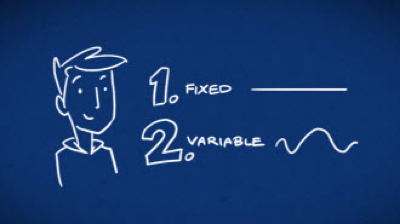The question of fixed rate mortgage versus variable rate mortgage stays the same, but the answer should, and does, change with the changes in the market.
Let’s start with the basics, variable mortgage rates (VRMs) are based on lenders’ Prime Rate, which is based on the Bank of Canada’s (BoC) overnight rate, and when the BoC raises or lowers their rate, Prime usually follows.
VRMs usually offer a lower payout penalty if breaking the mortgage mid-term, as most would only charge three months rather than an Interest Rate Differential (IRD). Note, not all IRDs are created equal; some can be quite shocking, especially if your mortgage is with one of the Big Six banks.
Historically, VRMs have saved their clients a lot of money, so if you choose this option, you’ve got some compelling historical evidence on your side.
The BoC continues to remain cautious about Canada’s economic outlook, which makes it’s highly unlikely that they will raise the overnight rate any time soon and there is even some talk that they could lower it to further stimulate the economy.
With a potentially lower payout penalty, historical evidence, and no real threat of a rate hike looming, you might now be wondering why doesn’t everyone choose a VRM, and knowing this, why wouldn’t I, an expert in mortgages, recommend a VRM to all of my clients?
Here’s why.

Regarding payout penalties? While it’s true that variable rate penalties can be lower than fixed-rate IRD penalties, it’s not always the case. IRD penalties should only kick in when the rate you are paying is higher than the rate available on the market when you payout the mortgage. So rates would have to decline below todays historically ultra-low rates for that to be a factor, unless you have a fixed-rate mortgage with one of the Big Six banks. If IRD is charged, the penalty would just be three months, the same as a VRM.
The historical evidence, while true for the past, isn’t the same for the future. The discount offered for much of the last decade was 70 to 100 basis points, at present it is zero to 35 basis points.
Lastly, there’s the qualifying. To qualify for a VRM the borrower has to qualify at the Bank of Canada Posted Rate, which is presently 4.64%, whereas to qualify for a fixed-rate the borrower qualifies using the actual rate, meaning some people won’t qualify for a VRM, even if they wanted a VRM.
The fixed versus variable question is essentially a risk/reward trade off. While you’ll pay a little more for a five-year fixed rate today, I think that today’s variable-rate risks outweigh their potential rewards, and that’s why I am recommend fixed-rate options to most of my borrowers.
Co-written with Martin Breeze, Mortgage Broker, TMG The Mortgage Group



Leave A Comment